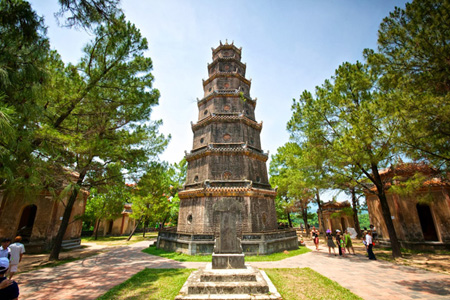In the mid fourteenth century, the Tran Dynasty started to decline. The high-ranking mandarin Ho Quy Ly usurped the throne of the Tran and founded the Ho Dynasty, which ruled from 1400 to 1407. The Ho Dynasty named the country Dai Ngu...
In the mid fourteenth century, the Tran Dynasty started to decline. The high-ranking mandarin Ho Quy Ly usurped the throne of the Tran and founded the Ho Dynasty, which ruled from 1400 to 1407. The Ho Dynasty named the country Dai Ngu, moved the capital city from Thang Long to Thanh Hoa, and vainly attempted to implement several socio-economic and cultual renovations. The Chinese Ming Dynasty invaded Vietnam in 1407. Le Loi, a hero from Thanh Hoa, staged the Lam Son resistance against the Ming which lasted from 1418 to 1428. After defeating the Ming, Le Loi proclaimed himself king and founded the early Le Dynasty. The Le Dynasty changed the country's name to Dai Viet, and ruled for ninety-nine years from 1428 to 1527 over the lifetime of ten kings. They included Le Thai To (1428-1433) under the reign name of Thuan Thien, Le Thai Tong (1433-1442) under the reign names of Thieu Binh or Dai Bao, Le Nhan Tong (1442-1459) under the reign names of Dai Hoa or Dien Ninh, Le Thanh Tong (1460-1497) under the reign names of Quang Thuan or Hong Duc, Le Hien Tong (1497-1504) under the reign name of Canh Thong, Le Tuc Tong (1504) under the reign name of Thai Trinh, Le Uy Muc (1505-1509) under the reign name of Doan Khanh, Le Tuong Duc (1509-1516) under the reign name of Hong Thuan, Le Chieu Tong (1516-1522) under the reign name of Quang Thieu, and Le Cung Hoang (1522-1527) under the reign name of Thong Nguyen.
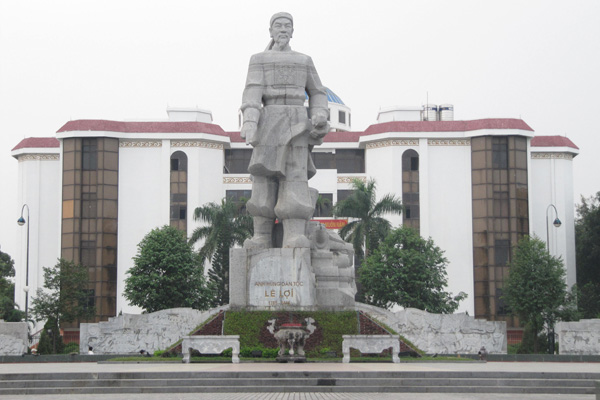
The Le Dynasty was the most complete and centralized feudal dynasty in Vietnamese history. It gave prominence to Confucianism, and Buddhism was no longer protected by the Court. The Court governed society under the legendary Code of Law Hong Duc. However, beginning with the reign of King Le Uy Muc, the Le Dynasty gradually declined and finally fell into the hands of the Prime Minister Mac Dang Dung. The Mac Dynasty lasted for sixty-five years, from 1527 to 1592, with five kings. They included Mac Dang Dung (1527-1529) under the reign name of Minh Duc; Mac Dang Doanh (1530-1540) under the reign name of Dai Chinh; Mac Phuc Hai (1541-1546) under the reign names of Quang Hoa; Mac Phuc Nguyen (1546-1564) under the reign names of Vinh Dinh, Canh Lich or Quang Bao; and Mac Mau Hop (1564-1592) under the reign name of Thuan Phuc.
With the help of Nguyen Kim from Thanh Hoa, King Le Trang Tong drove the Mac to Cao Bang and restored the Le Dynasty (also known as Le Trung Hung or restored Le). However, the Mac Dynasty continued its reign in Cao Bang up to 1677. The restored Le Dynasty lasted 255 years with sixteen kings. They included Le Trang Tong (1533-1548) under the reign name of Nguyen Hoa; Le Trung Tong (1548-1556) under the reign name of Thuan Binh; Le Anh Tong (1556-1573) under the reign names of Thien Huu, Chinh Tri or Hong Phuc; Le TheTong (1573-1599) under the reign names of Gia Thai or Quang Hung; Le Kinh Tong (1600-1619) under the reign names of Hoang Duc or Hoang Dinh; Le Than Tong (1619-1643) under the reign names of Vinh To, Duc Long or Duong Hoa; Le Chan Tong (1643-1649) under the reign name of Phuc Thai; Le Than Tong (1649-1662) under the reign name of Khanh Duc; Le Huyen Tong (1663-1671) under the reign name of Canh Tri; Le Gia Tong (1672-1675) under the reign name of Duong Duc; Le Hy Tong (1676-1705) under the reign name of Vinh Tri; Le Du Tong (1705-1728) under the reign name of Vinh Thinh; Le Duy Phuong (1729-1732) under the reign name of Vinh Khanh; Le Thuan Tong (1732-1735) under the reign name of Long Duc; Le Y Tong (1735-1740) under the reign name of Vinh Huu; Le Hien Tong (1740-1786) under the reign name of Canh Hung; and Le Man De (1787-1788) under the reign name of Chieu Thong. The restoration of the Le dynasty did not make the country prosperous, but instead led to conflicts between the Trinh Lords in the North (Dang Ngoai) and the Nguyen Lords in the South (Dang Trong). Thus, the country fell into a state of "power ambiguity," given the presence of the Le, Mac, Trinh and Nguyen. Yet, the kings became nominal while the lords held real power. Both of them had "governing bodies."
You may also like some more tours provide by us at: Vietnam Tour, Luxury Tours Vietnam
The Trinh ruled the Northern part of the country for 248 years (1545-1787) with eleven lords: Trinh Kiem (1545-1570), Trinh King (1570-1623), Trinh Trang (1623-1652), Trinh Tac (1653- 1682), Trinh Can (1682-1709), Trinh Cuong (1709-1729), Trinh Giang (1720-1740), Trinh Doanh (1740-1767), Trinh Sam (1767- 1782), Trinh Tong (1782-1786) and Trinh Bong (1786-1787). The Nguyen lords reigned over the Southern part for 202 years (1600- 1802) with nine lords: Nguyen Hoang (1600-1613), Nguyen Phuc Nguyen (1613-1635), Nguyen Phuc Lan (1635-1648), Nguyen PhucTan (1648-1687), Nguyen Phuc Tran (1687-16691), Nguyen Phuc Chu (1691-1725), Nguyen Phuc Chu (1725-1738), Nguyen Phuc Khoat (1738-1765), Nguyen Phuc Thuan (1765-1777) and Nguyen Phuc Anh (1780-1802). During this period, the civil war between the Northern and Southern dynasties and the hostilities between the Trinh and the Nguyen caused socio-economic stagnation across the country and suffering among the people for his grandchild at the Thien Phuc Pagoda (present-day Thay Pagoda), while the Mac royal family and mandarins took part in reparing and enlarging pagodas such as Tra Phuong Pagoda that worshipped Mac Dang Dung, Pho Minh Pagoda that worshipped Lady Mac, and Boi Khe Pagoda that worshipped Lady Ngoc Han
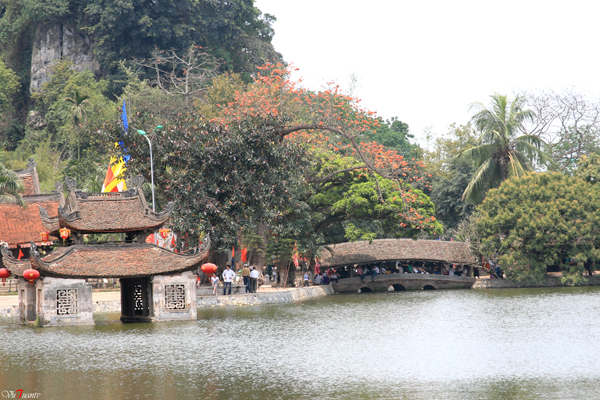
In the period of North and South Courts, although they were not Ch'an monks and did not feel it necessary to bring Buddhism into their rule, the Trinh and Nguyen Lords were devout Buddhists. They had pagodas rebuilt and repaired. In 1648, Trinh Trang had the Phuc Long Pagoda built in Kinh Bac. In 1719, Trinh Cuong had it rebuilt on an even larger scale. When the pagoda was inaugurated, Trinh Cuong declared a one-year tax exemption for the three adjacent districts. In 1727, Trinh Cuong had the Thien Tay Pagoda (in present-day Vinh Phuc Province) and the Doc Ton Pagoda (in present- day Thai Nguyen) built. In 1930, Trinh Giang had the Quynh Lam Pagoda (in present-day Dong Trieu) and the Sai Nghiem Pagoda (in present-day Chi Linh) rebuilt, building the Ho Thien Pagoda (in Kinh Bac) and the Huong Hai Pagoda (in present- day Chi Linh) in 1736. In 1737, Trinh Giang ordered a large bronze Buddha statue cast for the Quynh Lam Pagoda and sent mandarins to attend services in shifts. Other Trinh Lords also had many pagodas built and rebuilt. Several eminent Buddhist monks were favoured by the Le Kings and the Trinh Lords. The Le and Trinh Courts still used the hierarchy instituted by the previous feudal dynasties like Tang thong and Tang cuong. In this period, there were famous monks such as Ch'an Master Chuyet Chuyet, Ch'an Master Chan Nguyen, and Ch'an Master Huong Hai. Chuyet Chuyet (1590-?), whose real name was Ly Thien To from China, was admired by Lord Trinh Trang and King Le Huyen Tong and became their teacher. He sent people to China to acquire Buddhist scriptures for Lord Trinh Trang' to reprint in Vietnam. Chan Nguyen (1647-1726), whose real name was Nguyen Nghiem from Hai Duong and who stayed at the Long Dong Pagoda (Yen Tu), was appointed Tang thong.
He collected works of the Truc Lam Ch'an sect. Chan Nguyen wrote many books about Buddhism. His books are imbued with Ch'an thought, and he was considered the restorer of the Truc Lam Ch'an sect. When he died, King Le Du Tong had a stupa built in his honor at the Long Dong and Quynh Lam Pagodas. Ch'an Master Nhu Hien (?—1765) from Hai Duong was initiated into monkhood at the Long Dong Pagoda at the age of sixteen. He was an excellent disciple of Chan Nguyen and was appointed Tang thong by King Le Hien Tong. Huong Hai (1627-1715) from the Nguyet Duong Pagoda was invited by King Le Du Tong to the palace to conduct a service to pray for the king to produce an heir, and to teach Buddhist dogmas.
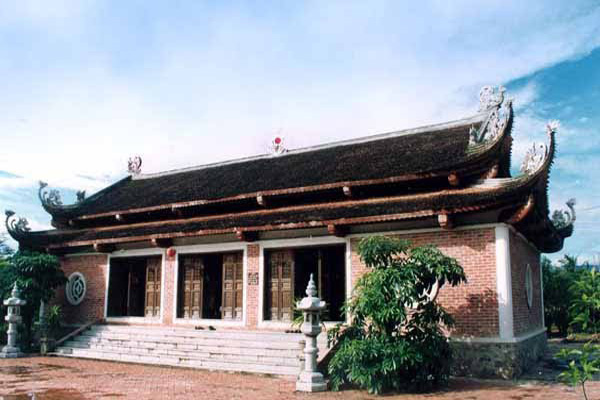
The Nguyen Lords in the South relied on both Confucianism and Buddhism to rally forces to deal with the Trinh Lords in the North, and to enlarge their territory at the same time. From Dong Do towards the South, they built a citadel and rampart and strengthened forces in the Thuan Quang region. In 1601, Lord Nguyen Hoang had the Thien Mu Pagoda built. The pagoda was associated with the ancient legend of Ba Troi (Heavenly lady) and the prophecy of the emergence of a lord in the South. Nguyen Hoang also built pagodas within his territory such as Sung Hoa, Bao Chau, Long Hung and Kinh Thien. In 1665, Lord Nguyen Phuc Tan started to rebuild the Thien Mu Pagoda, which was finished during the reign of Lord Nguyen Phuc Chu.
Nguyen Lords such as Nguyen Phuc Tan, Nguyen Phuc Chu and Nguyen Phuc Khoat ordered the construction and renovation of many pagodas, cast bells and acquired Buddhist scriptures from China in order to further develop Buddhism in Vietnam. The Nguyen Lords were considered strong supporters of Buddhism in the South.
The Nguyen Dynasty began in 1802 and relied chiefly on Confucianism. The attitude towards Buddhism differed among the Nguyen Kings. When King Gia Long ascended the throne, he issued a royal decree on the reorganization of Buddhism, banning the building of new pagodas, limiting Buddhist services for prayer, and prohibiting solemn and costly pagoda festivals. Some latter kings of the Nguyen Dynasty, especially King Tu Duc, issued similar royal decrees regarding Buddhism. As a result, some historians state that the Nguyen Dynasty was the hardest on Buddhism. However, in the South, Buddhism was once the spiritual support for the Nguyen Kings in gathering the masses to enlarge the territory. Some Nguyen Kings, particularly King Minh Mang and King Thieu Tri overcame the prejudices of their predecessors and courtiers. They did not regard Buddhism as unfounded or superstitious, but rather favored it. Buddhism was promoted by the Nguyen Kings in charitable and humanitarian activities during war, national division and social disturbances. At this time, the Nguyen Kings ordered many stupa pagodas built and renovated all over the country, particularly in Hue and Thuan Hoa, which formed a system of both State and private pagodas. The court built pagodas, granted them land and donated money annually for maintenance. Resident monks of these pagodas were eminent monks who enjoyed honors granted by the King. Some major pagodas like Giac Hoang, Thien Mu, Dieu De, Long Quang and Thanh Duyen (Hue); Long Phuc (Quang Tri); Tam Thai (Quang Nam); and Phap Vu, Kim Chuong, Khai Tuong and Tu An (Gia Dinh), among others, were recognised by the King as State-ranked pagodas that supported Buddhist activities. Private pagodas were built with money donated by aristocrats, influential families and the laity. Nguyen Khoa, a high-ranking mandarin, built the Ba La Mat Pagoda in Vi Da; Ung Bang built a pagoda and hiajesidence behind the Dieu De Pagoda. Minister Thai Van Toan built the Quy Thien Pagoda behind the Nam Giao Worshipping Esplanade; eunuchs donated money to the building of the Tu Hieu Pagoda. Ladies of the royal family in particular were devout Buddhist followers who contributed greatly to the spread of Buddhism in the Thua Thien - Hue region.
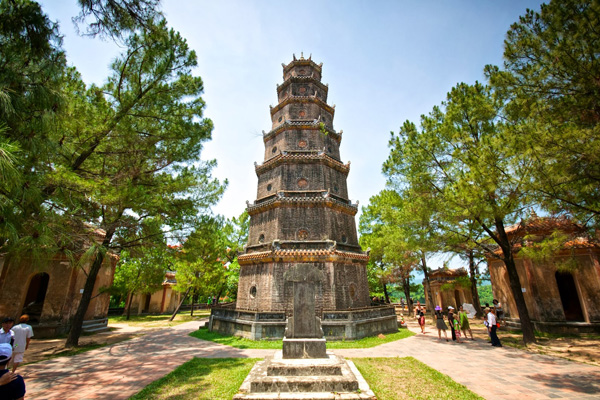
The publishing of Buddhist scriptures and canons was an important activity under the Nguyen Dynasty. Erudite monks like Venerable Superiors Phuc Dien, An Thien, Thanh Dam and Dieu Nghiem collected Buddhist books, revising them and compiling new ones for publication. Monks and laypeople from pagodas, such as Thuy Sam, Dia Tang, Tam Thien Phat and Dai Du Gia (in the South), and Bo Da, Tu Quang and Lien Tong (in the North) donated money and energy to printing those books, including significant Buddhist sutras like Hoa nghiem (Avatamsaka-sutra), Duoc su (Bhaisajya-guru-vaidurya- prabhasa), Thuy sam, Phap hoa (Saddharma-pundarika-sutra), Dia tang (Ksitigakha), Tam bao (Three Refuges or Triratna) and Tam Thien Phat (Three Thousand Buddhas); or such works as Thien uyen tap anh ngu luc, Tam to thuc luc, etc. Thanks to this effort, a rich collection of Buddhist works belonging to the three categories of Tripitaka aided by the propagation of Buddhist thought among the masses and exerted a great influence on contemporary Confucian scholars.
In the seventeenth century, there was a transition in China from the Ming Dynasty to the Qing Dynasty, which caused much turbulence in Huanan region. During the seventeenth century and early eighteenth century, several migrations of Chinese people to the South are recorded. Among them there were many eminent monks. As a result, two Ch'an sects emerged in Vietnam: the Cao Dong Ch'an sect in the North and the Lin Ji Ch'an sect in the South. During the reign of Le The Tong (1573-1599), Ch'an Master Thuy Nguyet from Thai Binh went to Feng Huang Mountain in China to search for the Buddha's dharma and became the thirty-fifth succession of the Cao Dong Ch'an sect in China. Upon obtaining the Dharma, he returned to Vietnam and founded the Hong Phuc Pagoda (in present-day Hoe Nhai, Hanoi) and became the patriarch of the Cao Dong Ch'an sect in the North. So far, there has not been research conducted on the patriarchs and Ch'an masters of this sect, but the Hong Phuc Pagoda is considered the ancestral pagoda of this sect in Vietnam. At the same time, the Cao Dong Ch'an sect was brought to the South by Ch'an Master Shi Lian from Zhexi (China) who was invited by Lord Nguyen Phuc Chu in 1695.
The patriarch of the Lin Ji Ch'an sect in the South was Yuan Shao (1649-1729) from Chao Zhou (Guangdong, China). In 1677, he went to Qui Nhon to lead a religious life and established the Thap Thap Pagoda. He then went to Thuan Hoa to build the Ha Trung Pagoda, and to Xuan Kinh to build the Quoc An Pagoda and the Pho Dong stupa. Ch'an Master Lieu Quan (1667-1742) from Phu Yen (Vietnam) was Yuan Shao's successor, continuing the Lin Ji Ch'an sect. However, due to Lieu Quan's great influence, Lin Ji Ch'an followers in the South ofter considered themselves followers of Lieu Quan's Ch'an school or Yuan Shao's Ch'an school. There has not been any rsearch conducted on the number of patriarchs and Ch'an masters of this sect.
Apart from the Cao Dong and Lin Ji Ch'an sects there was another Ch'an sect in the North known as Lien Tong's Ch'an Ml hool, founded by Ch'an Master Trinh Thap (1696-1773) during the reign of King Le Hy Tong (1675-1705). This Ch'an sect was not successful in expanding its influence. Some pagodas of the Lien Tong Ch'an sect still remain, including Lien Phai (Hanoi), Ham Long (Bac Ninh) and Nguyet Quang (Hai Phong).
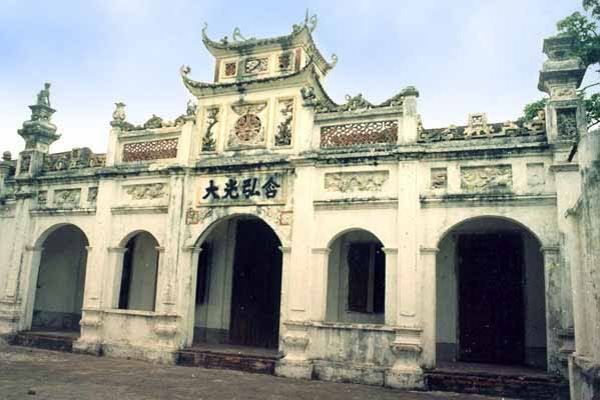
The three centuries of the Le, Mac, Trinh, and Nguyen dynasties were wrought with much socio-political upheaval. Although Buddhism was no longer as prominent as in earlier periods, many monks were deeply attached to the Buddha's doctrines and to the nation. There were typical monks – many of whom were of the Cao Dong and Lin Ji Ch'an sects - such as C’h'an Masters Huong Hai, Chan Nguyen, Lieu Quan, and Toan Nhat (1705-1832), Venerable Superiors Trung Dinh, Bui Dang Truong and Phuc Dien; Ch'an Master Thanh Dam; and Venerable Superiors Nhat Dinh (?-1847), Dieu Giac (7-1896) and Giac Ngo.
Ch'an Master Huong Hai was born in 1627 in the South. His father was a meritorious official during the reign of the Nguyen Lords. Studying hard, he passed the interprovincial examination for recruiting mandarins at the age of eighteen and was appointed prefect of Trieu Phong, Quang Tri. At the age of twenty-eight, he resigned and adopted a monastic life. Because of a misunderstanding on the part of the Nguyen Lord with him, he came to the North. Here, he was invited by the Le Kings and Trinh Lords to lead a religious life in Son Nam in the North. Huong Hai was often invited to the royal palace by King Le Du Tong to talk about Buddhist doctrine and to conduct services to pray for the king to produce heirs. He wrote twenty works on Buddhism like Giai kinh Phap Hoa, Giai Kinh Kim cuong ly nghia and Quan vo luong tho kinh. His works were influenced by the patriarch Hue Nang as well as the Pure Land school and Tantrism. He also expressed the concept of "three doctrines from the same source":
Parting from urban life to live in a pagoda
So opportune is my choice so far
My bed by the open window, inviting the moon to come
My sleep is caressed by gentle breezes whispering
Pavilions and towers glitter in mystery
Bells and drums convey miraculous sounds
As the three doctrines are of the same nature
I’ve never been made prejudiced.
Ch'an Master Chan Nguyen was born in 1647 in Hai Duong. He left home and become a monk at the Hoa Yen Pagoda at the age of nineteen. After attaining the Dharma, he became the resident monk of the Long Dong Pagoda, Yen Tu. Zen Master Chan Nguyen was considered responsible for the restoration of Truc Lam traditions and trained many excellent disciples, including Ch'an Masters Nhu Trung and Nhu Hien. Chan Nguyen was given the title Vo thuong cong (Peerless Noble) by king Le Du Tong in 1692. In 1772, he was appointed Tang thong; and given the title Chinh giac (Sambodhi). Chan Nguyen left behind many valuable works on Buddhism such as Ton su phat sach dang dan thu gioi, Long thu tinh do van tu, Tinh do yeu nghia and Ngo dao nhan duyen. He had deep knowledge of Buddism, thus he saw human life in a light-hearted way:
The day is divided clearly into twelve hours Such is its own nature - let it show up by itself Use the six sense-organs to recognize the Truth And thousands of dharmas to become enlightened.
Ch'an Master Toan Nhat's name, hometown, year of birth and year of initiation into monkhood are unknown. Some documents say that he joined the Tay Son army before turning to a religious life at the age of thirty. He attained Buddhist Dharma when he was forty-three, and he was a disciple of Ch'an Master Dieu Nghiem. Later, he was an assistant of Nguyen Hue. He wrote many books on Buddhism, including thirty works and thirty poems in Nom (Vietnamese demotic script), of which the book Hua su truyen is the most prominent. His works are deeply imbued with Ch'an Buddhist thought with a sense of being engaged in the life of the country and attached to the people. In particular, he attached more importance to the teacher than to the king or father in the

